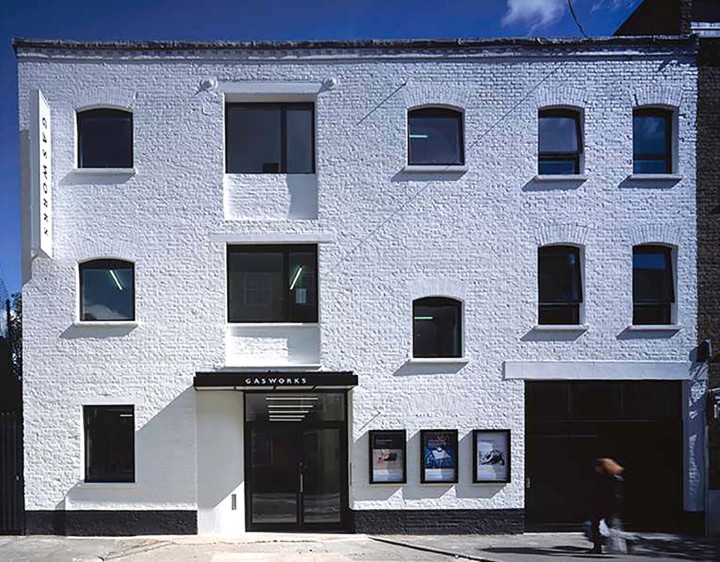Having supported artists within the London scene for over two decades, Gasworks has recently undergone a major redevelopment by architects HAT Projects and reopened to the public on September 24.
With more studio space alongside a program of exhibitions, educational events and residencies, the expansion further enhances the organization’s role as a hub for the exchange of ideas between international and local practitioners. Director Alessio Antoniolli describes the challenges that Gasworks has faced within the rapid urban regeneration of London, and how its raison d’être as an organization primarily supporting emerging artists will remain the same.
What role has Gasworks played in the arts ecology of London — a scene that ranges from large-scale institutions to commercial galleries and then smaller-scale grassroots organizations?
For over twenty years Gasworks has played a unique role in London, working at the intersection between UK and international practices and debates. Process and development are fundamental to us, which is why most of our building houses workspaces. Through our programs we establish long-term relationships with emerging artists so they can confidently make a significant new step in their professional career, whether the outcome is a work-in-progress, an event or an exhibition. In a city that has such a strong commercial presence, Gasworks’ role as an experimental and process-based space adds significantly to the richness of the local scene. This is often highlighted through our partnerships and collaborations with peers that include other members of Common Practice, Open School East, Tate Modern, University of the Arts and many others.
How has the redevelopment of Gasworks broadened the scope of your programming?
We will continue to deliver our programs of residencies, exhibitions, outreach activities and events. Our architects, HAT Projects, have found fantastic solutions for reorganizing the layout of the building, carving out two extra studios for London-based artists, doubling the size of the gallery, creating a purpose-built events space and adding a much needed kitchen and a terrace to enhance the feeling of “home.” The building is also going to have a better presence on the street, making us a lot more visible and inviting to audiences. Renovating Gasworks is allowing us to think more ambitiously about our programs, focusing on the distinct role of each, but also considering how they may be integrated and where they intersect. Ultimately we will continue to be a space that serves emerging artists’ needs to research, make and show their work.
Located in the South East of London, will the redevelopment change the role and influence of Gasworks within this area specifically?
With the progressive closure of studio spaces in London to make room for regeneration projects, our main concern was first to purchase and then make the building that has been our home since the beginning fit for purpose. Achieving that means that we secured our future in this rapidly changing area of London and can continue to provide studios for locally based artists, as well as build on our longstanding outreach work with the local community. As the area changes we are going to be joined by Damien Hirst’s new space and Cabinet Gallery, which are both opening soon in our neighborhood. This is going to make Vauxhall an exciting destination for a variety of audiences and attract new people to the area.
Gasworks is a networked organization that connects with partners globally; how important is this network in terms of the opportunities that Gasworks can offer artists?
Gasworks is the hub of the Triangle Network, an international network of grass-roots organizations and projects worldwide. As such, partnerships are at the core of our exchange projects, both for international artists coming to do residencies in the UK as well as for UK-based artists doing residencies with our partners abroad. Our partners also guide our research and offer unparalleled access to emerging scenes in Latin America, Africa, Asia, etc. This means that we can reach artists at early stages of their careers and really make a difference to their professional development through residencies, commissions and other projects that give them opportunities to make new work and disseminate their ideas.
With the unveiling of the new space, there’s an exhibition of newly commissioned work by emerging South African artist Kemang Wa Lehulere. What interested you in working with this artist for the reopening?
We’ve been interested in his work for a while. Although he is in many ways more established than most of the artists that contribute to Gasworks’ exhibitions program, he has not yet presented a solo exhibition in the UK. His interests in history and site-specificity also coincide with issues that have been relevant to Gasworks for many years. Wa Lehulere creates works, events and environments that explore the history and present-day realities of South Africa while at the same time engaging with the architecture of the places in which he works. We have therefore given him the gallery over the summer and are excited to work closely with him over this period to realize a whole new body of work for Gasworks’ reopening.


